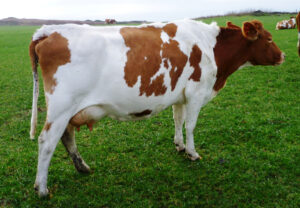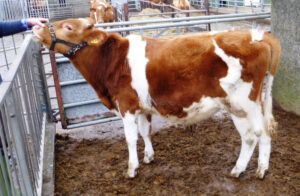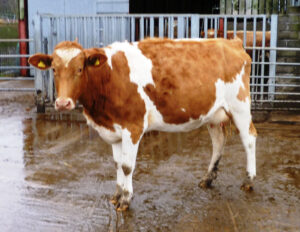The Alderney Herd
I visited Alderney this week and on what was my third visit, came away very impressed with the improvements that continue to be made by the hard work and enthusiasm of the Cox family.
Clare and Mike and elder son Stuart are involved full time, with daughter Hannah and Stuart’s girlfriend Chloe and younger son Craig all helping out with the milk and meat processing operation.
When Mike and Clare first came to the Island they undertook to maintain the grassland of the whole Island either by grazing or by topping, they soon came to realize that time spent topping was a poor use of their resources and so have increased the grazing numbers in two ways.

With only about two thousand residents, the market for dairy products is fairly finite, although there is greater demand between April and August with holiday makers, but access is expensive with only 12 passengers at a time accommodated at a time on the airplanes.
As the yields of the herd have risen (now over 7500 kg) so the number of cows have been reduced, currently 35 but they have access to grass all the year round and Mike notices that if they are denied fresh grass for any length of time then the quality of the milk shoots up from its already high level.
Mike and Clare have added a full range of beef products to the milk product range and are currently making a substantial investment in a slaughterhouse on the farm, to replace the existing Island facility which is outdated and no longer meets Environmental requirements. The alternative would be to send the beef animals to Guernsey, but with only one ship a week willing to take livestock and that being subject to prevailing weather conditions, it once took six weeks before a breeding bull could be returned, the extra cost and uncertainty probably justify the decision.
The “beef” is mainly provided by Guernsey steers which are reared at grass, until the final finishing period when they are run with the milking herd and can then be fed some finishing “nuts” in the yard and get used to being handled and reach slaughter weight at about 24 months of age. As the demand has grown bull calves are being imported on a monthly basis from Guernsey from one of the larger herds.
The same herd also sends all of his heifer calves to Alderney where they stay until they are close to calving for the first time when they return home. A weekly rate has been agreed and provides a reasonable extra income but also means that the expensive “topping” operation is no longer necessary as there are now more than 200 Guernseys on the Island using the grass. The current plan is now to bring some of the “waste” ground back into production to increase the grazing acres.
The Island is mainly a sandy soil and is therefore suitable for all year grazing, but is also prone to drought and a dry summer this year did reduce the available big bale silage stocks and so some barley straw has been imported from England and the cost of shipping effectively doubled the cost!
The Cox’s are now milking the third generation of cows since they arrived and one cow family has impressed them in particular the “Bows”. I remember taking a picture of the original Bow on my first visit and she milked until she was 14 years old and classified VG 88, her Maypennant daughter is also VG 88 and milking in her 8th lactation and she has a Silverado daughter who will also Classify VG and she has a smart son by Pine Ridge Double L. There is also an outstanding In calf heifer by Cornelius from the same family.



I came away full of admiration for what the family are achieving on Alderney and it was interesting to hear from Mike that since he has improved the “nutrition” of his cows , he finds that his “problems” with Somatic Cell Counts and Fertility have reduced. The herd is milk recorded with NMR and it would be interesting to use the “Herd Companion” figures which are for a rolling period of five years to look at the changes.
